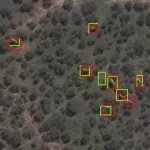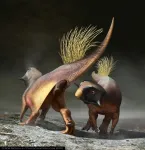Counting elephants from space
Satellite images processed with the help of computer algorithms are a promising new tool for surveying endangered wildlife.
2021-01-19
(Press-News.org) For the first time, scientists have successfully used satellite cameras coupled with deep learning to count animals in complex geographical landscapes, taking conservationists an important step forward in monitoring populations of endangered species.
For this research, the satellite Worldview 3 used high-resolution imagery to capture African elephants moving through forests and grasslands. The automated system detected animals with the same accuracy as humans are able to achieve.
The algorithm that enabled the detection process was created by Dr Olga Isupova, a computer scientist at the University of Bath in the UK. The project was a collaboration with the UK's University of Oxford and the University of Twente in the Netherlands.
Dr Isupova said the new surveying technique allows vast areas of land to be scanned in a matter of minutes, offering a much-needed alternative to human observers counting individual animals from low-flying airplanes. As it sweeps across the land, a satellite can collect over 5,000 km² of imagery every few minutes, eliminating the risk of double counting. Where necessary (for instance, when there is cloud coverage), the process can be repeated the next day, on the satellite's next revolution of Earth.
The population of African elephants has nose-dived over the past century, mainly due to poaching and habitat fragmentation. With only 40,000-50,000 elephants left in the wild, the species is classified as endangered.
"Accurate monitoring is essential if we're to save the species," said Dr Isupova. "We need to know where the animals are and how many there are."
Satellite monitoring eliminates the risk of disturbing animals during data collection and ensures humans are not hurt in the counting process. It also makes it simpler to count animals moving from country to country, as satellites can orbit the planet without regard for border controls or conflict.
This study was not the first to use satellite imagery and algorithms to monitor species, but it was the first to reliably monitor animals moving through a heterogeneous landscape - that is, a backdrop that includes areas of open grassland, woodland and partial coverage.
"This type of work has been done before with whales, but of course the ocean is all blue, so counting is a lot less challenging," said Dr Isupova. "As you can imagine, a heterogeneous landscape makes it much hard to identify animals."
The researchers believe their work demonstrates the potential of technology to support conservationists in their plight to protect biodiversity and to slow the progress of the sixth mass extinction - the ongoing extinction event triggered by human activity.
"We need to find new state-of-the-art systems to help researchers gather the data they need to save species under threat," said Dr Isupova.
African elephants were chosen for this study for good reason - they are the largest land animal and therefore the easiest to spot. However, Dr Isupova is hopeful that it will soon be possible to detect far smaller species from space.
"Satellite imagery resolution increases every couple of years, and with every increase we will be able to see smaller things in greater detail," she said, adding: "Other researchers have managed to detect black albatross nests against snow. No doubt the contrast of black and white made it easier, but that doesn't change the fact that an albatross nest is one-eleventh the size of an elephant."
INFORMATION:
The paper Using very?high?resolution satellite imagery and deep learning to detect and count African elephants in heterogeneous landscape is published in the Journal of Zoology.
The researchers involved in this project were Dr Olga Isupova from the University of Bath, Isla Duporge, Dr Steven Reece, and Professor David W. Macdonald from the University of Oxford, and Dr Tiejun Wang from the University of Twente.
[Attachments] See images for this press release:

ELSE PRESS RELEASES FROM THIS DATE:
2021-01-19
People's fear of 5G technology is rational. Such technology does emit radiation, even if it's at low levels. But 5G isn't all that different from 4G, and it certainly doesn't cause COVID-19 despite such rumors having spread rapidly across the globe.
Researchers need to better understand how misinformation like this spreads in order to hone their intervention efforts and prevent misinformed perspectives from taking root. In society's virtual world, preventing technological misinformation, in particular, is important now more than ever.
A research team led by Elaine Nsoesie, a Hariri Institute Faculty Fellow, investigated how COVID-19 misinformation proliferated using ...
2021-01-19
A new study out of the University of Chicago and Stanford University on pairs of twins with and without food allergies has identified potential microbial players in this condition. The results were published on Jan. 19 in the Journal of Clinical Investigation.
The study grew out of prior research in the Nagler laboratory at UChicago on the fecal microbiota in infants. By transplanting fecal microbes from healthy and food-allergic infants to germ-free mice (who do not possess a microbiome), investigators found that the healthy infant microbiota was protective against the development ...
2021-01-19
The synthetic chemicals known as PFAS, short for perfluoroalkyl and polyfluoroalkyl substances, are found in soil and groundwater where they have accumulated, posing risks to human health ranging from respiratory problems to cancer.
New research from the University of Houston and Oregon State University published in Environmental Science and Technology Letters suggests why these "forever chemicals" - so called because they can persist in the environment for decades - are so difficult to permanently remove and offers new avenues for better remediation practices.
The work focused on the interactions sparked when firefighters use ...
2021-01-19
The abnormal immune system response that causes multiple sclerosis (MS) by attacking and damaging the central nervous system can be triggered by the lack of a specific fatty acid in fat tissue, according to a new Yale study. The finding suggests that dietary change might help treat some people with the autoimmune disease.
The study was published Jan. 19 in The Journal of Clinical Investigation.
Fat tissue in patients diagnosed with MS lack normal levels of oleic acid, a monounsaturated fatty acid found at high levels in, for instance, cooking oils, meats (beef, chicken, and pork), cheese, nuts, sunflower seeds, eggs, pasta, ...
2021-01-19
With a name like glucose-6-phosphate dehydrogenase deficiency, one would think it is a rare and obscure medical condition, but that's far from the truth. Roughly 400 million people worldwide live with potential of blood disorders due to the enzyme deficiency. While some people are asymptomatic, others suffer from jaundice, ruptured red blood cells and, in the worst cases, kidney failure.
Now, a team led by researchers at the Department of Energy's SLAC National Accelerator Laboratory have uncovered the elusive mechanism behind the most severe cases of the ...
2021-01-19
WASHINGTON, January 19, 2021 -- What causes brain concussions? Is it direct translational or rotational impact? This is one of the research areas currently being explored by Qianhong Wu's lab at Villanova University.
Our brains consist of soft matter bathed in watery cerebrospinal fluid (CSF) inside a hard skull. An impact on the hard skull is transmitted through the thin layer of CSF within the subarachnoid space to the soft brain matter.
In Physics of Fluids, from AIP Publishing, Wu and co-authors Ji Lang and Rungun Nathan describe studying another system with the same features, an egg, to search for answers. An egg resembles the brain, because its soft yolk is bathed within a liquid egg white inside a hard shell.
Considering that in most concussive brain injuries, the skull does ...
2021-01-19
For the first time ever, a team of scientists, led by the University of Bristol, have described in detail a dinosaur's cloacal or vent - the all-purpose opening used for defecation, urination and breeding.
Although most mammals may have different openings for these functions, most vertebrate animals possess a cloaca.
Although we know now much about dinosaurs and their appearance as feathered, scaly and horned creatures and even which colours they sported, we have not known anything about how the vent appears.
Dr Jakob Vinther from the University of Bristol's School of Earth Sciences, along with colleagues Robert Nicholls, a palaeoartist, and Dr Diane Kelly, ...
2021-01-19
With a small snout, a short and curled tail, and a big, round stomach, mini pigs are the epitome of cute--and sometimes, they snore. Now, researchers think these snoring pigs can be used to study obstructive sleep apnea. A study appearing January 19 in the journal Heliyon found that obese Yucatan mini pigs do have naturally occurring sleep apnea and that MRI scans taken while they're in sedated sleep can be used to gain new insights into what happens in the airways during sleep apnea episodes via computational flow dynamic (CFD) analysis.
"These are very fat pigs," says first author Zi-Jun Liu, a research professor and principal investigator in the Department of Orthodontics ...
2021-01-19
WASHINGTON, January 19, 2021 -- Biomedical engineers developed a technique to observe wound healing in real time, discovering a central role for cells known as fibroblasts. The work, reported in APL Bioengineering, by AIP Publishing, is the first demonstration of a wound closure model within human vascularized tissue in a petri dish.
Prior investigations of wound healing have used animal models, but healing in humans does not occur the same way. One difference is that wounds in mice and rats, for example, can heal without granulation tissue, a type of tissue critical to the healing of human wounds.
Granulation tissue forms after blood coagulates, and the wound scabs over. Coagulation creates a fibrin network that serves as a temporary matrix. Granulation tissue then takes over, ...
2021-01-19
WASHINGTON, January 19, 2021 -- The quest for ever-smaller electronic components led an international group of researchers to explore using molecular building blocks to create them. DNA is able to self-assemble into arbitrary structures, but the challenge with using these structures for nanoelectronic circuits is the DNA strands must be converted into highly conductive wires.
Inspired by previous works using the DNA molecule as a template for superconducting nanowires, the group took advantage of a recent bioengineering advance known as DNA origami to fold DNA into arbitrary shapes.
In AIP ...
LAST 30 PRESS RELEASES:
[Press-News.org] Counting elephants from space
Satellite images processed with the help of computer algorithms are a promising new tool for surveying endangered wildlife.




